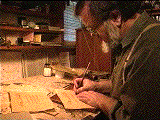Islamic Culture and the Medical Arts

Islamic Calligraphy with Mohamed Zakariya
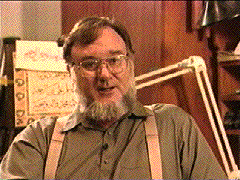
Film/Exhibit Credits | Notes About This Exhibit
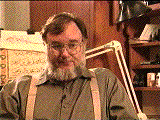
[Transcribed from the spoken words of Mohamed Zakariya]
Writing basically consists of ordinary writing and calligraphic writing. Ordinary writing is what we normally use, it's what everybody uses in their daily life. Calligraphic writing is a specialty of writing whereby the writing is made into an art form.
 4.7 MB
4.7 MB
There is ordinary writing. There is what we would call the scribal tradition of writing, which is existing in all these cultures as well, which is the trained production by professionals of texts, whether they be government documents, books, tablets, anything which requires an individual who might be akin a little bit to a modern secretary or a modern printer, in a sense, to produce reading material.
The Chinese and Japanese have a calligraphic tradition.The Hebrew culture has one. The Hebrew traditions often required the writings to be of a very permanent nature for the religious purposes and that meant works on parchment with a degree of penmanship that was consistent with total legibility and authenticity. That really is what we would call the scribal tradition in writing. The Islamic culture has one; the Latin and Greek cultures have one; the Armenian culture has one. It exists in many many forms.
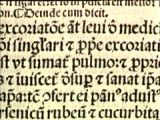 Now in the normal, well not normal, but in the cultures that have alphabets which are discrete, Hebrew, Latin, Armenian, Greek, the letters form little blocks that are not attached to each other.
Now in the normal, well not normal, but in the cultures that have alphabets which are discrete, Hebrew, Latin, Armenian, Greek, the letters form little blocks that are not attached to each other.
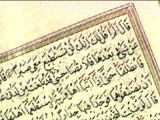 In the Islamic tradition, the writing is connected and so it has a different aspect to it than the others do involving many connections that are made between the letters.
In the Islamic tradition, the writing is connected and so it has a different aspect to it than the others do involving many connections that are made between the letters.
The writing system really is not a difficult system. It works well with all kinds of languages. It's a very simple alphabet. It senses that it can be a shorthand. The fact that it's connected causes people to have problems with it, and also the problem that it is not generally written in a straight line but in a series of diagonals. So that allows a very good hand expression, but a very bad transition to fixed print.

In the Islamic tradition, the calligraphic art usually existed as a part of the religious tradition, whereby religious texts, as well as what some would consider secular texts, but they often had a religious base to them, were produced to a level of art that was not consistent with just scribal work. In other words, they were done by master calligraphers who were thought of in an artistic sense. There were personalities who achieved high levels of the art and were sought after and collected and became famous individuals who were respected and revered throughout history, a little bit like we think of painters. They often produced the elaborate and beautiful Koranic manuscripts which were very important in the Islamic culture, and indeed most of your high calligraphy that developed from that angle from those people who were doing the Korans. Rarely do you see books in the Islamic world that were calligraphed to the degree that the Korans generally are.
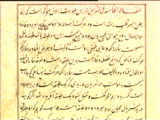
The library has got mostly works from what we would call the scribal tradition, all the way from some extremely difficult-to-read pieces that are in no way connected with calligraphy; they are more akin to doctors' notes.
 [This image appears in the exhibition Islamic Culture & the Medical Arts]
[This image appears in the exhibition Islamic Culture & the Medical Arts]
The illustrations you will notice right away are schematics. Generally speaking they are not naturalistic. They were thematic, in that they would describe one particular area of the body, such as the nervous system, in a geometrical fashion that is hardly recognizable as being human. That is interesting from an Islamic arts standpoint, because it tends to follow the older Islamic practice of avoiding naturalism in art.
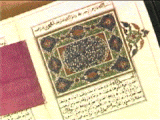 A lot of the books in the collection are of a higher standard than that, and sort of cross the border into calligraphic works. Some are of a more regular scribal level; some approach calligraphy.
A lot of the books in the collection are of a higher standard than that, and sort of cross the border into calligraphic works. Some are of a more regular scribal level; some approach calligraphy.
 The one in particular that has always interested me in the collection is the Jildaki manuscript called the Burhan, the alchemical work that was done in Morocco, I think probably in the 19th century or somewhere in that area. I think it's probably the finest example of Moroccan manuscript production in the entire country. It's simple, legible, on an attractive paper, the gilding is not overdone. It's restrained but it's inventive, everything in it.
The one in particular that has always interested me in the collection is the Jildaki manuscript called the Burhan, the alchemical work that was done in Morocco, I think probably in the 19th century or somewhere in that area. I think it's probably the finest example of Moroccan manuscript production in the entire country. It's simple, legible, on an attractive paper, the gilding is not overdone. It's restrained but it's inventive, everything in it.
 There's not one example of gilding in the seven volumes of the book that is redundant; and yet it's all of a theme, so it's a wonderful conception from start to finish. It's a total product.
There's not one example of gilding in the seven volumes of the book that is redundant; and yet it's all of a theme, so it's a wonderful conception from start to finish. It's a total product.
There were a number of books printed, as we were saying, on the lithograph technique. There is one in the collections from India, a medical work that was done using the lithograph press, which means that the artist would use the lithograph ink and the lithograph paper and do his work on that and it was transferred onto one of the soft lithograph stones and then the papers were printed from that. It's a long and time consuming process, but they had often very good results.
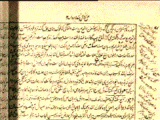 This is a good example of that. It will show, if I'm not mistaken -- well, the paper might not be as good as the hand made books -- but it will show how calligraphy does transfer in the lithograph situation.
This is a good example of that. It will show, if I'm not mistaken -- well, the paper might not be as good as the hand made books -- but it will show how calligraphy does transfer in the lithograph situation.
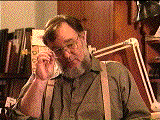 What I'm going to do is to walk you through the entire production of a small piece as it would be done in a calligraphic album.
What I'm going to do is to walk you through the entire production of a small piece as it would be done in a calligraphic album.
 2.1 MB
2.1 MB
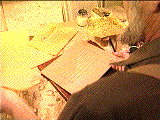 This is the slate that you use to put the lines on the paper; it's a very interesting invention. In other words, you don't have to make lines with a pencil. It doesn't mess your paper up. You just place this over the paper and rub and the line comes up.
This is the slate that you use to put the lines on the paper; it's a very interesting invention. In other words, you don't have to make lines with a pencil. It doesn't mess your paper up. You just place this over the paper and rub and the line comes up.
 5.3 MB
5.3 MB
Now I'm ready to get to work. First we take some magnesium carbonate.
I'm using a porcupine quill to stir the ink a little bit and get it nice and fluid. I'll be using an ink that I make myself. It takes me six weeks to make about a quart. It involves burning a linseed oil and kerosene mixture. I do it the backyard; it makes the neighbors really curious what's going on. It's kind of fiery and smokey.
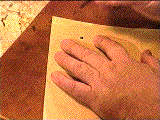 That's mixed with gum arabic. It's ground for 30 hours in a mortar and pestle after this. I'm using a European based paper; it's an English paper. These were exported throughout the Islamic world. They were exported in a state that is not usable as it comes. Number one, they were white and no calligraphy uses white paper; it's an eyesore; it hurts the eyes. You have to add some color to it. Often they were dyed with teas, as this paper has been dyed with tea.
That's mixed with gum arabic. It's ground for 30 hours in a mortar and pestle after this. I'm using a European based paper; it's an English paper. These were exported throughout the Islamic world. They were exported in a state that is not usable as it comes. Number one, they were white and no calligraphy uses white paper; it's an eyesore; it hurts the eyes. You have to add some color to it. Often they were dyed with teas, as this paper has been dyed with tea.
 5.6 MB
5.6 MB
What I have chosen for the thing are some texts and quotations from the important legal personality Malik ibn Anas who was a second century Islamic figure, of very big importance. He was founder of the Malikite school of Islam, which was predominate throughout all of North Africa and Spain and West Africa, a very widespread school of Islamic interpretation. I have just written the word "the Imam Malik has said." Actually, going to the grammar and the layout, the verb in Arabic goes first so it says, "he said," and then the subject "Imam." The name "Malik" is going to happen right now.
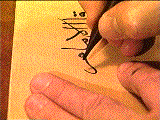 Now the next part of the design is to put in the vowels. The vowels, the reading marks, and a few of the other items are put in separately.
OK, that's the large piece of writing.
Now the next part of the design is to put in the vowels. The vowels, the reading marks, and a few of the other items are put in separately.
OK, that's the large piece of writing.
 3.8 MB
3.8 MB
It's called the script called sulus or thuluth. The next script is called nasih or naskhi, and it is the script which most texts are written in. What we first want to find is how long it will be and find good place to put it. OK, that's it. That's that part. Now I'll make the lines and finish with the other stuff.
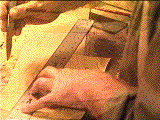 Now I'm cutting the paper. This will be in preparation towards gluing it up.
Now I'm cutting the paper. This will be in preparation towards gluing it up.
 2.7 MB
2.7 MB
We will see the glue-up using wheat starch. And that is a traditional method of gluing-up. It is a simple starch that is boiled in the double boiler on the stove.
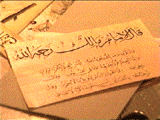 [The paper, ready to begin the gluing process]
[The paper, ready to begin the gluing process]
In the previous times when this was a more organized art, this work was done by somebody else, by a professional who would cut it and follow up with the gluing-up process. OK, that's ready. That's done.
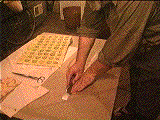
 3.6 MB [Cutting the inner border]
3.6 MB [Cutting the inner border]
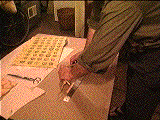
 3.4 MB [Cutting the outer border]
3.4 MB [Cutting the outer border]
I'm cutting here the marble papers that are going to be used for the inner borders. The papers that I'm using as decorative borders and backings are what we call marble papers. I produce them myself. They are done according to the Turkish technology of marbling, rather than the European kind which is similar but different. The outer marbles will be different and contrasting, but they both harmonize with the inner border; so that makes them, although they are not exactly the same size, a rather good pair.
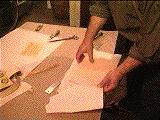 This is my back piece; that goes on first. The piece here is wet. It has been soaked for about ten minutes so that it's very relaxed
and it rolls out good. Dry off the excess. You have to work fast with this or else things can get into trouble. They get too soaked then they can delaminate. This is the glue that's made of starch.
This is my back piece; that goes on first. The piece here is wet. It has been soaked for about ten minutes so that it's very relaxed
and it rolls out good. Dry off the excess. You have to work fast with this or else things can get into trouble. They get too soaked then they can delaminate. This is the glue that's made of starch.
 6.5 MB
6.5 MB
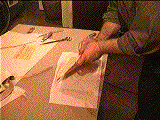 Now we roll out the extra glue.
Now we roll out the extra glue.
 3.3 MB
3.3 MB
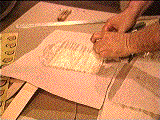 By eye, you can position it.
By eye, you can position it.
 4.1 MB
4.1 MB
That's it. The whole lamination has been done. It's been laminated on the back and the front. It will stay stable that way. It will dry in this position, and tomorrow I'll take it down and cut off the borders and burnish it up and apply the gold and finish the piece off.
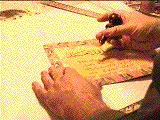 This is burnishing with the agate burnisher. The object is to flatten the surface to make it smooth. It also compacts it and makes the ink more a part of the paper.
This is burnishing with the agate burnisher. The object is to flatten the surface to make it smooth. It also compacts it and makes the ink more a part of the paper.
 4.0 MB
4.0 MB
Now we'll begin the process of gilding. The gold I use is a gold made from gold leaf. They are produced by taking the gold leaf, usually in large batches, and pulverizing it with your finger with a mixture of extremely thick gum arabic and a plate of frosted glass. This is done basically nine to 11 times. It's a morning-'til-night job and you can't be stopped in the middle.
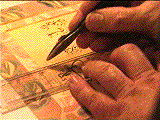 It's put on over the seams so the seams don't show. A little golden design that sort of are a little bit like punctuation. Here the green gold is put in for metallic contrast.
It's put on over the seams so the seams don't show. A little golden design that sort of are a little bit like punctuation. Here the green gold is put in for metallic contrast.
 5.2 MB
5.2 MB
This stage here will be the burnishing stage where the gold is rubbed down and given its brilliance.
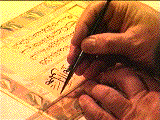 You notice when the lines are on, the black line, it makes everything begin to look coherent so it forms a finished-looking effect.
You notice when the lines are on, the black line, it makes everything begin to look coherent so it forms a finished-looking effect.
 2.9 MB
2.9 MB
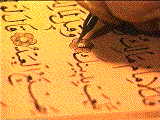 The pattern is generally made up of groups of three dots or straight lines.
The pattern is generally made up of groups of three dots or straight lines.
 2.2 MB
2.2 MB
This is not a deep impression but it does leave a little patterning in the gold. Now the final stage is putting just a little bit of color.
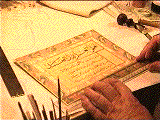 The white line, this finishes it off. This makes the piece complete. Without the white line, it doesn't work very well; with the white line, it looks complete.
The white line, this finishes it off. This makes the piece complete. Without the white line, it doesn't work very well; with the white line, it looks complete.
 2.6 MB
2.6 MB
In the history of this art, lots of different colors of line here were tried, but white is the most successful.
And that's it.
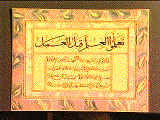 This is from the maxims of Imam Malik and he says in this case, "Learn knowledge before you do anything." He's making a very important statement according to the Islamic philosophy, which is you really need to know about what you're going to do before you ever undertake it, rather than rushing headlong into things.
This is from the maxims of Imam Malik and he says in this case, "Learn knowledge before you do anything." He's making a very important statement according to the Islamic philosophy, which is you really need to know about what you're going to do before you ever undertake it, rather than rushing headlong into things.
 4.0 MB
4.0 MB
About Islamic Calligraphy with Mohamed Zakariya | Film/Exhibit Credits | Table of Contents (Islamic Culture and the Medical Arts)



